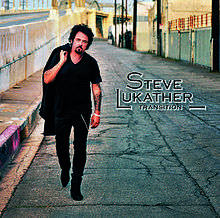
Transition (Chipmunk album)
Transition is the second studio album by English hip-hop artist Chipmunk. It was released on 15 April 2011 by Jive Records in the United Kingdom, but was set to be released in the United States on 12 July 2011 by RCA Records at the same time with Jive Records and Sony Music Entertainment. The album debuted at number 10 in the United Kingdom, with first-week sales of 9,445 copies.
Background
While discussing Transition, Chipmunk said, "It kinda represents the growth in me as a person since my last album, so the sound has matured as well as I have and that’s the main thing for me with the record - I just wanted the sound, the sound and the feel of the album to feel… I feel like a granddad but you know, just more mature than my first album, you know life’s changed." The album features American artists Keri Hilson, Chris Brown, Trey Songz,Kalenna Harper from Diddy-Dirty Money, Jamaican dancehall musician Mavado and British rapper Wretch 32. In late 2010, the second single off Transition, "Champion" had leaked onto the Internet. In an interview with BBC Newsbeat, Chipmunk said: "When it [the track] leaked, I was looking at the sky asking, 'God, why?’ I just didn't understand. The amount of thought process that went into that track, the amount of battles we had for that track."

Transition (Steve Lukather album)
Transition is the seventh studio album by Steve Lukather, released on vinyl and as a jewel case CD on January 21, 2013 by Mascot Records. In Europe a limited edition Digibook was also released, containing a booklet with studio pictures and liner notes from Lukather and producer C. J. Vanston.
Track listing
Personnel
Transition (fiction)
Transitions in fiction are words, phrases, sentences, paragraphs, or punctuation that may be used to signal various changes in a story, including changes in time, location, point-of-view character, mood, tone, emotion, and pace. Transitions are sometimes listed as one of various fiction-writing modes.
Purpose of transitions
Transitions provide for a seamless narrative flow as a story shifts in time, location, or point-of view. They aid the internal logic of a story by moving readers from sentence to sentence, paragraph to paragraph, idea to idea, scene to scene, and chapter to chapter with grace and ease..
Types of transition
Transitions in fiction may take any of several forms, including chapter breaks, section breaks, and summarization.
See also
Footnotes
References
Acme
Acme (/ˈækmiː/; Greek: ακμή, akmē, /ˈɑːkmɛ/, the peak, zenith, prime) is a Greek word denoting the best of something. It may refer to:
Arts and entertainment
Science and technology

Acme (steamboat)
The steamboat Acme operated on Lake Washington and also on the Sammamish Slough to Bothell, Washington from 1899 to 1910, when it was destroyed by fire.
Construction and design
Acme was built in Seattle in 1899 on the Lake Washington shore. The builders were Gustavus V. Johnson (1845-1926) & Son. Gustavus V. Johnson was a Civil War veteran, who had been born in Clayton County, New York and who had established a boat building business on Lake Minnetonka in Minnesota. He and his son Mark ran one of the earliest boatyards on Lake Washington (established 1888). In addition to Acme, they built vessels such as L.T. Haas and City of Renton.
Acme was built of wood and was 60 ft (18.29 m) long, with a beam of 11.5 ft (3.51 m) and depth of hold of 3 ft (0.91 m). The overall size of the vessel was 31 gross and 21 registered tons. The official U.S. registry number was 107460.Acme has been described as a tug.
Operation
Acme was operated between Leschi and Madison parks and Bothell, Washington by N.C. Peterson. The vessel was used to service Leschi and Madison parks for one year, and thereafter being sold to the Bothell Transportation Company for use on the Bothell run.Acme was also under the ownership of John L. Anderson, one of the most important figures in steamboat navigation on Lake Washington. In 1906, Acme was making twice-daily trips from Madison Park to Bothell, a distance of 22 miles (35 km) from Seattle.

Acme (solitaire)
Acme is a Canfield type of solitaire game using 1 deck of playing cards.
Layout
Acme has 4 Tableau Stacks of 1 card each, and they build down in suit. There are 4 Foundations that build up in suit. The Reserve Pile contains 13 cards which can be played onto the Foundations or Tableau Stacks. The deck turns up 1 card at a time.

Rules
Only the top card of a Tableau stack can be moved. These cards can be moved to a Foundation or onto another Tableau stack. The Tableau builds down in suit, and the Foundations build up in suit. Cards from the Reserve automatically fill empty spaces. Any card can fill empty Tableau spaces after the Reserve is empty. There is only one redeal allowed in this game, so only 2 passes through the Deck are allowed.
Tips & Strategies
Rather than using the cards from the deck, try to use all of the reserve cards first. Only two passes are allowed, so use the deck wisely.
Acme II
In this variation, whole tableaux piles can be moved rather than just the top card.
Podcasts:

